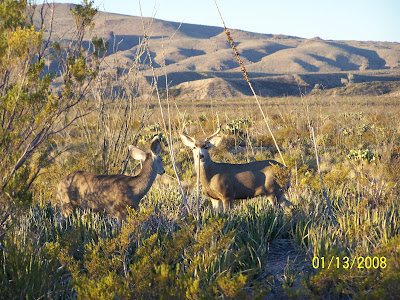
We walked across the desert with friend and professional ranger Bob Hamilton who led us to museum-quality matates and manos (mortars and pestles) used by early Homo sapiens perhaps as much as 8000 years ago—a time when the whether was cooler, rivers flowed through cottonwood groves and game was abundant. Areas abound with numerous stone hearths used to cook sotol, other plants, and game as these early hunter-gatherers moved back and forth across the area when the ice from the last ice age was still receding.
Game was probably considerably more abundant than it is today but one needs not invest more than time to see the abundant wildlife in this park.
 Our list of wildlife observed includes antlered mule deer bucks with small herds of does, pig-like javelina, exotic Barbary sheep or Aoudad, and even Desert Big Horn sheep.
Our list of wildlife observed includes antlered mule deer bucks with small herds of does, pig-like javelina, exotic Barbary sheep or Aoudad, and even Desert Big Horn sheep.The cooler weather has put the desert reptiles into hibernation so we leave here without seeing the expected assortment of rattlesnakes and lizards but the migration of the tarantulas made up for the absence of the reptiles.
This is a geologic wonderland that defies my attempts to decipher how ancient physical forces of heat, pressure, time, and weather, lifted up, twisted, contorted, and eroded solid and plastic mud and mineral into amazing natural monuments and sculptures.

The park is simply too big to allow anyone to see all of it. There is so much that we will not experience this trip: mountain lions and bears have eluded us; miles of trails remain unhiked; century old adobe ruins, abandoned homesteads, and even entire settlements of former inhabitants are unexplored.
We did get to canoe though the Santa Elena Canyon as part of the parks exceptional volunteer training program but Mariscal and Boquillas and Lower Canyons are still virgin territory. Our two week training program exposed us the natural, geologic, and human history of the park via day-long guided tours with professional naturalists, archeologists, paleontologists, and historians.

There is so much we did and yet so much remains undone. We enjoyed working the visitor center and leave knowing we mad a difference to many park visitors. Impromptu interpretive programs with visitors in and around the visitor center as well as on trails and at sites around the park have given us considerable satisfaction and the positive show of appreciation of the visitors is an unparalleled reward. I realize that my primary reason for volunteering at Big Bend, to give interpretive programs, was unfulfilled, but maybe there will be another time. I know without a shadow of doubt that doing interpretive and educational programs is the direction I need to focus on for future volunteer assignments.
We’ve said our goodbye’s to most of our friends and are beginning to look forward to heading back east to spend some time with family and friends.
